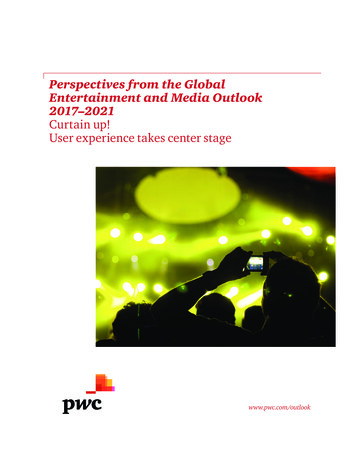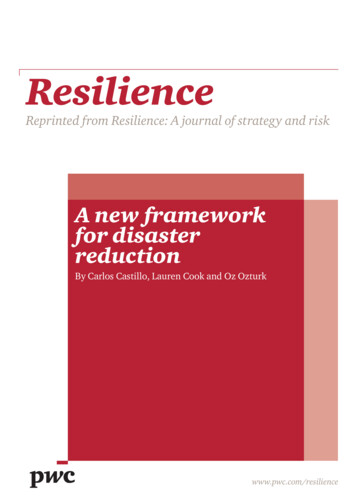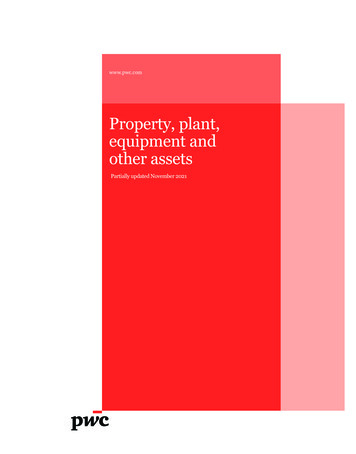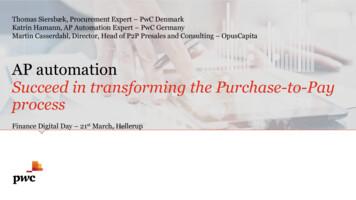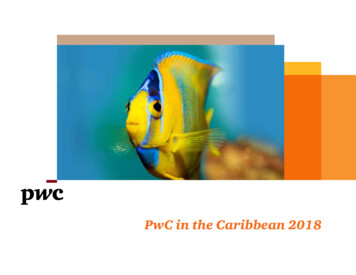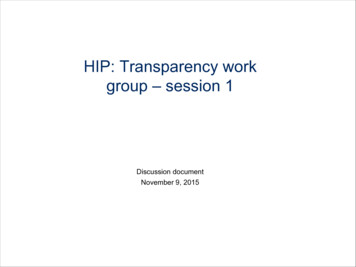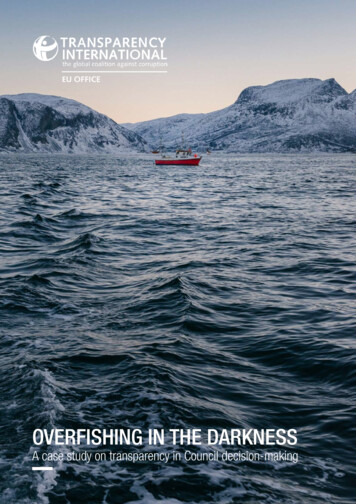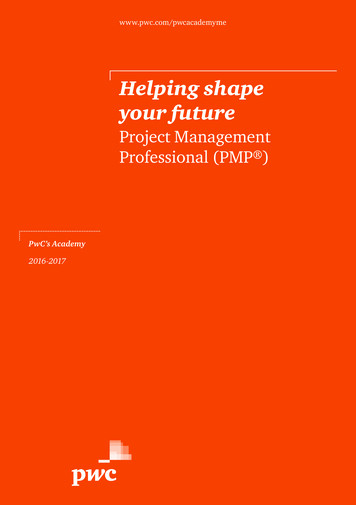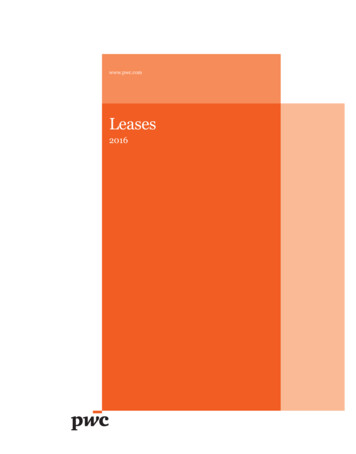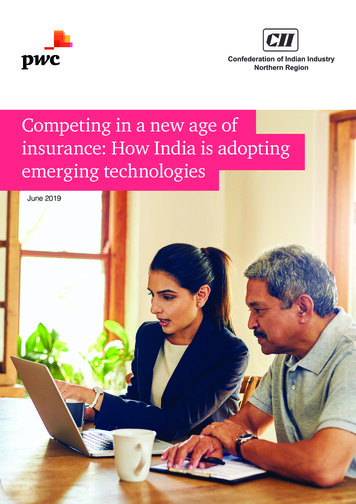
Transcription
TransparencyReportfor the year ended30 June 2021PricewaterhouseCoopers UAB
Contents03Message from leadership09Our approach to quality14Cultures and values25Our peoplePwC Transparency report29Our audit approach34Monitoring37Legal and governance structure39PwC network2
Message fromleadershipOurapproach toqualityCultures andvaluesPwC Transparency reportOur peopleOur auditapproachMonitoringLegal andgovernancestructurePwCnetwork3
Message from leadershipWelcome to our 2021 Transparency reportThis report includes information about how the firm is governed. While PwC is a multidisciplinary firm,this report is primarily focused on our audit practice and related services. The audit profession continuesto be under significant public scrutiny and challenge. We understand the concerns and we support andare committed to changes that will improve audit quality.At PwC, our purpose is to build trust in society and solve important problems. We’re a network of firmsin 156 countries with more than 295,000 people who are committed to delivering quality in Assurance,Advisory and Tax & Legal services.’ We are committed to drive a strong culture of quality andexcellence that is core to our purpose.In June 2021, we unveiled The New Equation, PwC’s landmark global strategy which responds tofundamental changes in the world, including technological disruption, climate change, fracturedgeopolitics, and the continuing effects of the COVID-19 pandemic. The New Equation is based onanalysis of global trends and thousands of conversations with clients and stakeholders. It builds onmore than a decade of sustained revenue growth and continued investment. The New Equation focuseson two interconnected needs that clients face in the coming years. The first is to build trust, which hasnever been more important, nor more difficult. The second is to deliver sustained outcomes in anenvironment where competition and the risk of disruption are more intense than ever and societalexpectations have never been greater. For more information on The New Equation, please seehttps://www.pwc.com/gx/en/Our Strategy continues to build on our ongoing commitment to quality.Our people are key to performing high quality audits and we draw upon a wide range of specialist skillsacross our multidisciplinary practice. That’s why we maintain a constant emphasis on our purpose andvalues that address integrity and independence. We continue to invest in our people by providingongoing professional and personal development, with in depth training.We have taken steps to align our business to support this focus on audit quality. We continuously investin innovation and new technology to support our services across the firm, to meet the changing auditchallenges in a digital age and to enhance the quality of our audit services.Taken together, these measures represent a significant transformation of our audit business andsupport our focus on audit quality and our public interest responsibilities.We have prepared this Transparency Report, in respect of the financial year ended 30 June 2021, inaccordance with the requirements of Article 13 of the EU Regulation No. 537/2014 and of the Council of16 April 2014 on specific requirements regarding statutory audit of public-interest entities.Rimvydas JogėlaCountry Managing PartnerVilnius, Republic of Lithuania 29 October 2021.4PwC Transparency report
A message from our Assurance LeaderTrust lies at the heart of everything we do atPwC. It’s fundamental to fulfilling our firm’spurpose. One of the ways we build trust is bybeing transparent.As auditors, we’re also acutely aware of anothertrust driver: the quality of our external audits.That’s why we’re pleased to present ourTransparency Report for our financial year ended30 June 2021, which shows how we maintainquality in our audit work. The report describesour policies, systems and processes for ensuringquality, the results of key quality monitoringprograms and reviews, and the way we foster aculture of quality at every level of the firm. Itdetails the companies we performed audits forand the total revenue from our audit and nonaudit work.Broadening the definition of auditquality: a balanced scorecardWe welcome the public conversations that ariseas a result of transparency about audit quality.We believe there are many factors thatcontribute to a quality audit and to get abalanced picture of audit quality in Lithuaniastakeholders need to see a range of measures.5PwC Transparency reportContinuing the discussion on auditqualityOur audit business is fundamental to our strategyand brand. We continue to invest in continuousimprovement in audit quality through newsystems and technology, risk processes andlearning and development for our people. I’mproud of the role we’re playing in opening updiscussion about audit quality inPricewaterhouseCoopers UAB. I welcome theopportunity to keep the conversation goingthrough our Transparency Report.Our ultimate goal is that [our regulator] considersthat we have obtained reasonable assurance inall audit areas. We are driving a qualityimprovement plan aimed at achieving this goalRasa RadzevičienėAssurance Leader
Year in reviewPartner and staff survey90 %of our staff and Partnersparticipated in our GlobalPeople Survey.Audit quality reviews - externalRestatementsResults from audit quality review for 2015-2017period - number of reviews, including the total numberresulting in findings.0Number of financialstatement restatementsinvolving PIE audits due tomaterial errorsX285 %of the respondents believethe leaders they work withencourage one-firmcollaborative behavior toprovide quality services toour clients.Without findings2015-201775 %With findings6Assurance Training calendar year 2021Assurance Training calendar year 2020Average hours achieved by Partners and staffAverage hours achieved by Partners and 85totalTotal hours completed: 5,742Total hours completed: 8,693Our system of quality managementAuditing and accounting training hoursNumber of hours spent on monitoring for CEE in totalNumber of hours of auditing and accounting training mandatedby PwC annually8300 hours for CEE region82 hours for territoryPartners2 findingsQuality findings identified and remediated / in processof remediating.ManagersSenior AssociatesReal time reviewsNumber of audit engagements included in the real timereview program:Associatesauditengagements7With over 2,000 hours spent by a fully dedicated team08,6936PwC Transparency report102030405060708090
Year in reviewAssurance Staff utilisation *Project managementFY21 utilisation hours by levelBudget to actual hours incurred for PIE ociates18.569Total hours57%FY20 utilisation hours by ssociates17.58616.99416.650FY21FY20Budget* time spent on audit engagements as a percentage oftotal time per each staff gradeActualsLeveraged ratio of audit-related hours for audit team ical support*Use of Service Delivery CentersRatio of total CEE Partnersserving in technical supportroles to the total number ofCEE audit PartnersPercentage of audit hoursperformed by ServiceDelivery CentersExperience ofour PartnersPartners’ average years ofexperience at PwC*) on CEE regional basis1 to 16.57PwC Transparency report5%21 years
Our quality improvementprogrammesAt PwC, we are continuously improving our audit quality through thedesign and operation of an effective system of quality management. Thisincludes a focus on the following key areas: Continuing to strengthen our quality culture to support our Partners andteams display behaviours consistent with driving audit quality Integration of the use of Assurance Quality Indicators to aim to predictquality, Real Time Assurance to aim to prevent quality issues, Root Causeanalysis to learn from quality issues and a Recognition & AccountabilityFramework to reinforce quality behaviours, cultures, and actions Increasing our focus on ongoing and real-time quality monitoring includingthrough the use of Real Time Assurance and Assurance Quality Indicators Developing an implementation plan that addresses explicit requirementsresulting from the recently approved IAASB quality management standards.However it is not expected that the changes related to ISQM 1 will have asignificant impact on our system of quality management (SoQM).In addition, we continue to engage with our stakeholders to have: Enhanced transparency of information about our business includingpublication of our balance scorecard Real time engagement around the changes we’re seeing in the world andtheir impact on audit quality and compliance, like technology disruption,climate change, geopolitics - changes that have been magnified andaccelerated by the COVID-19 pandemic“At PwC, our purpose is at the coreof what we do and why we do it.”Rimvydas Jogėla, PricewaterhouseCoopers UABCountry managing Partner8PwC Transparency report8
Our approachto qualityMessagefromleadershipCultures andvaluesPwC Transparency report guidanceOur peopleOur auditapproachMonitoringLegal andgovernancestructurePwCnetwork9
Our approach to deliveringquality services across all ouroperations and networkFocus on QualityMeasurement and transparencyThe quality of our work is at the heart of ourorganisation and we invest significant andincreasing resources in its continuousenhancement across all of our businesses. Thisinvestment is targeted into many different areas,including training (technical, ethical andbehavioural), methodologies, adding resourcesin key areas and exploring new ways ofdelivering our work. Each investment reflects acommon determination to understand the factorsthat drive quality and identify opportunities forenhancement.For all our businesses, each PwC firm – as partof the agreement by which they are members ofthe PwC network – is required to have in place arigorous SoQM; to annually complete a SoQMperformance assessment; and to communicatethe results of these assessments to globalleadership. These results are then discussed indetail with the leadership of each local firm and ifthey are not at the level expected, a remediationplan is agreed with local leadership takingpersonal responsibility for its successfulimplementation.We are also investing heavily in new technologyto drive continuous improvement in thecapabilities and effectiveness of all of ourservices.As our services change and develop, and theneeds and expectations of our stakeholders alsochange, we are continually reviewing andupdating the scale, scope and operations of oursystem of quality management and investing inprogrammes to enhance the quality of theservices that we provide.We are proud to have been the first of the globalprofessional services networks to have publishedits internal audit quality inspection results. It isvery important that we are transparent aboutboth the efforts that we are making to enhancequality, and also the results and the impact thatthese efforts are having. The publication of thisdata by our Network over the last few years,along with public discourse on the subject of theaudit, has quite rightly put an increasing focus onthe issue of audit quality, which we discuss indetail in this report.Definition and cultureAt PwC, we define quality service as one thatconsistently meets the expectations of ourstakeholders and which complies with allapplicable standards and policies. An importantpart of delivering against this quality definition isbuilding a culture across a network of 295,000people that emphasises that quality is theresponsibility of everyone [including our 185people]. Continuing to enhance this culture ofquality is a significant area of focus for our globaland local leadership teams and one which playsa key part in the measurement of theirperformance.10PwC Transparency reportFor example, we have recently renewed ourfocus on ‘tone at the top’ of our organisation andare creating the right culture for highperformance and high quality. Knowing howimportant tone at the top is, we are implementingan enhanced and consistent measurement ofleadership effectiveness and quality right acrossour network.
Specific focus on audit qualitySpecific focus on audit qualityIntegrated and aligned in the right wayDelivering quality audits is core to our purpose.To that end, we are committed to providing aquality audit. However, where our work fallsbelow the standards that we set for ourselvesand are set by the regulators, we take each ofthese instances very seriously and work hard tolearn lessons and to enhance the quality ofaudits that we undertake in the future.The quality objectives focus on having the rightpeople supported by effective methodologies,processes, and technology appropriately directedand supervised. These represent the capabilitiesthat we believe are relevant to achieving andsustaining audit quality. To help us achieve theseobjectives, there are a number of dedicatedfunctions at a network level that develop practicaltools, guidance and systems to support andmonitor audit quality across our network. Theseelements have been integrated and aligned byour network to create a comprehensive, holisticand interconnected quality managementframework that we tailor to reflect our individualcircumstances.The right objectives and capabilitiesTo help us put this strategy into effect, the PwCnetwork has established clear objectives aroundaudit quality and provides support to help usmeet these objectives. Our engagement teamscan only deliver quality audit services if theyhave access to the necessary capabilities – bothin terms of people and technology. That’s whyour quality objectives focus on having the rightcapabilities – both at a Member Firm level andacross our network – and on using thesecapabilities to meet our own standards and theprofessional requirements. These capabilitiescan only be developed under the right leadershipand quality culture, promoting the right valuesand behaviours.Delivering a quality end-productconsistentlyCentral to the framework is the recognition thatquality management is not a separate concept; itneeds to be embedded in everything we do asindividuals, teams, firms and the network. Thequality objectives are supported by designatedkey activities which are considered necessary toachieve the quality objectives, focused mainly onbuilding a quality infrastructure and organisation.We supplement and design those key activitiesas appropriate to respond to risks we haveidentified to achieving each quality objective.Values and judgmentsPerforming quality audits requires more than justthe right processes. At its core, an auditor’s roleis to assess with a “reasonable” degree ofassurance whether the financial statementsprepared by the company’s management arefree of “material misstatements” – reaching aprofessional judgment on whether the financialstatements present a fair picture of thecompany’s financial performance and position.To carry out this assessment effectively, theauditor needs to use all the capabilities that havebeen built up in line with our quality objectives.These include applying ethical behaviour inaccordance with PwC’s values, professionalscepticism, specialist skills and judgment – allsupported by technology.11PwC Transparency report
Delivering audit quality duringthe COVID-19 pandemicOur response to COVID-19The global COVID-19 pandemic has had anunprecedented impact on our clients and ourpeople, as well as global and local economiesand broader society.At PwC, in addition to safeguarding the health,safety and well-being of our people, we haveremained focused on working together as aNetwork, with our clients and other stakeholdersto continue to deliver audit quality.Sharing developments and experienceFrom the early stages of the pandemic, the PwCnetwork put a team in place to monitordevelopments globally and to highlight areas ofcritical importance to ensure we did notcompromise on audit quality. We have leveragedthe guidance developed by our Network and ourCEE Risk & Quality team to provide consistentleadership and guidance on audit quality andequip our teams to consider their client’s uniquecircumstances and respond accordingly.Our Network response was comprehensive andthis was supplemented by guidance shared byCEE Assurance leadership. It covered allaspects of audit quality, including regulatory andstandard setting updates, auditor reporting,methodology, accounting and learning andeducation. Using the Network and CEEguidance, we considered changes needed to ourexisting policies and procedures as well as whatneeded to be reinforced through appropriatecommunications to our staff and Partners.Identifying and addressing risks relatedto COVID-19The COVID-19 pandemic resulted in us facing anumber of new challenges in our audits. Thisranged from how we operate as a team to planand complete the audit, to how we interact withour clients to obtain the necessary auditevidence and execute specific audit proceduressuch as completing physical inventory counts.The foundation we have built for our system ofquality management helped us navigate some ofour biggest challenges as a result of thepandemic. We were able to monitor the actionswe took to address identified risks and assesswhether changes needed to be made on a realtime basis.We used the experience and examples sharedwith us from across the Network to support ourassessment of the issues that had the potentialto impact our system of quality management.We focused on enhanced supervision andreview, the use of consultations with specialistswithin our firm, enhanced Real Time Assuranceprograms to respond to the risks we identified.The investment in technology and moving quicklyto upskill our Partners and staff to workseamlessly in a digital world put us at theforefront in managing remote working during ourbusiest time of year without sacrificing quality inour audits. Our teams utilised the resourcesmade available and worked cohesively toexecute our audits remotely.We continue to monitor and respond to theongoing impacts of the pandemic on our peopleand clients including the implications of changingor easing restrictions.12PwC Transparency report
Management’s Statement onthe effectiveness of internalquality control systemfunctioningThe Country Managing Partner (CMP) ofPricewaterhouseCoopers UAB believes that the qualitycontrol environment described in this TransparencyReport is in compliance with all applicable regulationsand that it provides a reasonable basis for believing thatstatutory audits carried out by PricewaterhouseCoopersUAB consistently meet the required quality standards.Quality monitoring is an integral partPricewaterhouseCoopers’ UAB continuous improvementprogramme. PricewaterhouseCoopers UAB constantlyevaluates inputs from formal programmes and a varietyof informal sources in an ongoing effort to improvepolicies, procedures and the consistency of work quality.Instances of failure to meet performance standards, ifany are treated very seriously and the partnerresponsible is instructed to improve performance.Appropriate steps are taken to achieve improvementthrough all possible means which might include financialpenalties or even dismissals.Based on the reviews performed, the CMP ofPricewaterhouseCoopers UAB is satisfied thatPricewaterhouseCoopers UAB internal quality controlsystem is operating effectively. Any matters identifiedthrough the various monitoring and review processes areaddressed with appropriate corrective actions.Last Quality Assurance ReviewThe last external quality assurance review carried out in compliance with Article 26 of the Regulation 537/2014 was carried out byAuthority of audit, accounting, property valuation and insolvency management between May 2018 and October 2019 with the finalreport issued on 15 October 2019. According to the Council of 16 April 2014 on specific requirements regarding statutory audit ofpublic-interest entities. the regulatory inspection of audit firm are performed every 3 years.PricewaterhouseCoopers UAB continues to be registered to conduct statutory audit work in Lithuania.13PwC Transparency report
Cultures and valuesMessagefromleadershipOurapproach toqualityPwC Transparency reportOur peopleOur auditapproachMonitoringLegal andgovernancestructurePwCnetwork14
Cultures and valuesLeadership and Tone at the TopOur purpose and values are the foundation ofour success. Our purpose is to build trust insociety and solve important problems, and ourvalues help us deliver on that Purpose. Ourpurpose reflects ‘why’ we do what we do, andour Strategy provides us with the ‘what’ we do.‘How’ we deliver our purpose and strategy isdriven by our culture, values and behaviours.This forms the foundation of our system ofquality management and permeates how weoperate, including guiding our leadership actions,and how we build trust in how we do business,with each other and in our communities.When working with our clients and ourcolleagues to build trust in society and solveimportant problems, we: Act with integrity Make a difference Care Work together Reimagine the possibleKey messages are communicated to our firm byour Country Managing Partner and ourleadership team and are reinforced byengagement Partners. These communicationsfocus on what we do well and actions we cantake to make enhancements. We monitorwhether our people believe that our leaders’messaging conveys the importance of quality tosuccess of our firm. Based on this monitoring, weare confident our people understand our auditquality objectives.15PwC Transparency report
Delivering service of the highest quality is core toour purpose and our Assurance strategy, thefocus of which is to strengthen trust andtransparency in our clients, in the capital marketsand wider society.The Quality Management ProcessTo help PricewaterhouseCoopers UAB put thisStrategy into effect, the PwC network hasestablished a framework for quality managementwhich integrates quality management intobusiness processes and the firm-wide riskmanagement process. The framework introducesan overall quality objective for the Assurancepractice focused on having the people andprocesses to deliver services in an effective andefficient manner that meets the expectations ofour clients and other stakeholders. designing and implementing responses to theassessed quality risksThis overall quality objective is supported by aseries of underlying quality managementobjectives and our system of qualitymanagement (SoQM) must be designed andoperated so that these objectives are achievedwith reasonable assurance.The achievement of these objectives issupported by a quality management processestablished by our firm and Assuranceleadership, business process owners, andpartners and staff.This involves the integrated use of AssuranceQuality Indicators to aim to predict qualityissues, Real Time Assurance to aim toprevent quality issues, Root Cause Analysisto learn from quality issues and aRecognition and Accountability Framework toreinforce quality behaviours, culture andactions.These programs, by design, require ongoingmonitoring and continuous improvement, inparticular Assurance Quality Indicators,which we expect will evolve significantly overtime and as we continue to use and learnfrom these measures.16PwC Transparency reportThis quality management process includes: identifying risks to achieving the qualityobjectives monitoring the design and operatingeffectiveness of the policies and proceduresthrough the use of process-integratedmonitoring activities such as Real TimeAssurance as well as appropriate AssuranceQuality Indicators continuously improving the system of qualitymanagement when areas for improvement areidentified by performing root cause analysesand implementing remedial actions and establishing a quality-related recognition andaccountability framework to be used inappraisals, remuneration, and careerprogression decisionsAim to Predict: Assurance Quality IndicatorsWe have identified a set of Assurance QualityIndicators (AQIs) that support our Assuranceleadership team in the early identification ofpotential risks to quality, using metrics to aim topredict quality issues. This quality risk analysis isan essential part of our QMSE, and the AQIs, inaddition to other performance measures, alsoprovide a key tool in the ongoing monitoring andcontinuous improvement of our SoQM.
Aim to Prevent: Real Time AssuranceWe have developed a Real Time QualityAssurance (RTA) program designed to providepreventative monitoring that helps coach andsupport engagement teams get the ‘right work’completed in real-time, during the audit.Directed from the CEE region there is a team ofexperienced and dedicated auditors who carryout pre-issue reviews of audit files. Thesereviews are performed together with theengagement team through all phases of theaudit. The Assurance Leader identifies whichengagements should have such RTA review.Additionally, there are a number of audit qualityindicators (AQIs) that are monitored on andreported to country Assurance Leadership,Cluster Assurance Leadership [if applicable] andCEE Assurance Leadership. These AQIs areeither reported quarterly or annually dependingon their nature.Learn: Root cause analysisWe perform analyses to identify potential factorscontributing to our firm’s audit quality so that wecan take actions to continuously improve. Ourprimary objectives when conducting suchanalyses is to understand what our findings tellus about our SoQM and to identify how our firmcan provide the best possible environment forour engagement teams to deliver a quality audit.We look at quality findings from all sourcesincluding our own ongoing monitoring of ourSoQM as well as Network inspection of ourSoQM, audits both with and withoutdeficiencies—whether identified through our owninternal inspections process or through externalinspections and other inputs such as financialstatement restatements—to help identifypossible distinctions and learning opportunities.17PwC Transparency reportFor all individual audits, that are inspected, anobjective team of reviewers identifies potentialfactors contributing to the overall quality of theaudit. We consider factors relevant to technicalknowledge, supervision and review, professionalscepticism, engagement resources, and training,amongst others. Potential causal factors areidentified by evaluating engagement information,performing interviews, and reviewing selectedaudit working papers to understand the factorsthat may have contributed to audit quality.In addition, the data compiled for audits both withand without deficiencies is compared andcontrasted to identify whether certain factorsappear to correlate to audit quality. Examples ofthis data include whether this is a new auditengagement, whether the engagement wassubject to a pre-issuance review, and the timingof when the audit work was performed.Our goal is to understand how quality audits maydiffer from those with deficiencies, and to usethese learnings to continuously improve all of ouraudits. We evaluate the results of these analysesto identify enhancements that may be useful toimplement across the practise. We believe theseanalyses contribute significantly to the continuingeffectiveness of our quality controls.A direct output of the root cause analysis reviewis the preparation and presentation of lessonslearned provided to all engagement leaders andKey Audit Partners. This training is usually in thelast quarter of the calendar year.
Reinforce: Recognition and Accountability FrameworkOur Recognition and Accountability Framework (RAF) reinforces quality ineverything our people do in delivering on our Strategy, with a focus on theprovision of services to our clients, how we work with our people anddriving a high quality culture. It holds Partners including non-PartnerEngagement Leaders accountable for quality outcomes [beyondcompliance]. Our RAF considers and addresses the following keyelements: Quality outcomes: We provide transparent quality outcomes to measurethe achievement of the quality objectives. Our quality outcomes take intoaccount meeting professional standards and the PwC Network and ourfirm’s standards and policies Behaviours: We have set expectations of the right behaviours thatsupport the right attitude to quality, the right tone from the top and astrong engagement with the quality objective Interventions/recognition: We have put in place interventions andrecognition that promotes and reinforces positive behaviours and drivesa culture of quality Consequences/reward: We have implemented financial and nonfinancial consequences and rewards that are commensurate to outcomeand behavior and sufficient to incentivise the right behaviours to achievethe quality objectives18PwC Transparency report
Our detailed quality control procedures are setout in our PwC Audit Guide and in PwC NetworkRisk Management policies and guidance. Thepolicies and procedures are embedded as part ofthe firm’s day-to-day activities.Our quality management system is based on thesix elements of quality control set out in ISQC 1,which are: Leadership responsibilities for quality withinthe firm Ethical requirements Acceptance and continuance of clientrelationships and specific engagements Human resources Engagement performance MonitoringLeadership and accountabilityPwC CEE operates as an integrated practiceunder Regional leadership. The AssuranceStrategy, management team and reportingstructure is led by a CEE Assurance Leader,supported by a Regional AssuranceManagement Group (RAMG) – this primarycomprises Assurance Leader from the majorterritories/sub-clusters. The extended RAMGincludes functional leaders for Quality
PricewaterhouseCoopers UAB for the year ended 30 June 2021 . Contents PwC Transparency report 2 03 Message from leadership 09 Our approach to quality 14 Cultures and values 25 Our people 29 34 . Auditing and accounting training hours Number of hours of auditing and accounting training mandated by PwC annually Managers
